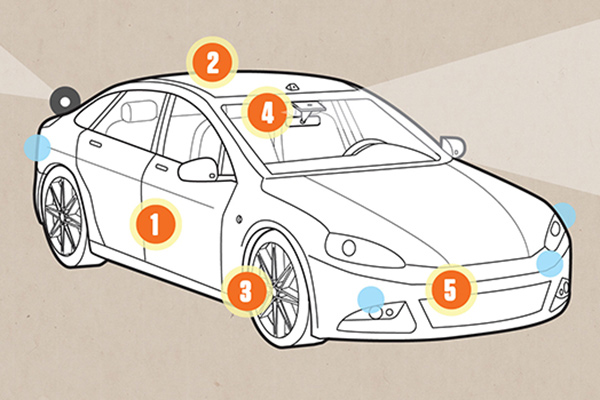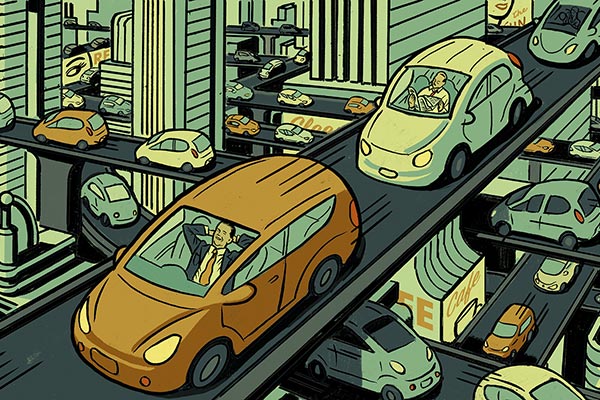Autonomous cars are already a reality—at least, they are in Phoenix, Ariz., where an autonomous vehicle company has partnered with a rideshare service. Its cars are already picking up and depositing riders—all without a human driver at the wheel.
While this has been a limited-scale project—in a city with normally good weather—being chauffeured around without a chauffeur is closer to becoming a common occurrence. The National Highway Traffic Safety Administration says that fully automated cars and trucks are on their way, 29 states have enacted legislation for allowing autonomous vehicles on their roads, and the U.S. Department of Transportation (DOT) recently announced plans to ease federal regulations surrounding autonomous vehicles.
The DOT’s rationale? Safety. As much as 94 percent of all serious automobile crashes are attributed to human error. Unlike human drivers, autonomous vehicles are not prone to distraction, fatigue or impaired driving.
So why aren’t we all buzzing around town in driverless vehicles? Why is it taking so long?
The Obstacles For Self-Driving Cars
There several issues that still need to be ironed out, say experts.
Weather
Just like a human driver, weather affects a driverless vehicle, says Melba Kurman, co-author of Driverless. If we can’t see in the fog, a camera can’t see in the fog, either—even an advanced camera that performs 360-degree scans up to 20 times per second and has deep-learning software to “teach” it to recognize objects.
However, that’s just one of the tools that autonomous vehicles use to “see.” There’s also LiDAR (light detection and ranging)—a sensing system that uses a spinning laser beam and calculates how long it takes for light to hit and then reflect back from an object. Cars also use radar, which measures radio waves to detect an object’s bearing, range and velocity.
Possible solution: Whether it’s LiDAR or better cameras that are used as the primary visual sensor, says Kurman, they are all feeding data into neural deep-learning networks and making autonomous driving systems smarter and better. “When companies are ready to invest in training driverless vehicles to handle snowy or foggy road conditions,” she says, “the cars’ performance will exceed that of a human driver.”
Liability & Insurance
This will be tricky, Kurman says, because if no one’s driving, who’s at fault if there’s an accident?
Possible solution: Policies and regulations will have to change to support the new technology—but they will, says Kurman. “Government and insurance companies will figure it out—after all, they’ve adapted to new technologies in the past.”
Non-standardized Road Markings
Signs and lights can vary by state—or even by municipality. Some traffic signals are horizontal, for example, while others are vertical. Plus, signs that mark the miles or exits along the highway aren’t the same from state to state, and if they’re damaged or old, they could be tough to read. If the car hasn’t learned all of the variables, there could be safety ramifications.
Possible solution: With artificial intelligence (AI) technology, computer-run vehicles are increasingly capable of learning at a rate far faster than humans. Eventually, cars will become smart enough that these variations won’t matter, says Paul Godsmark, chief technology officer of CAVCOE (formerly the Canadian Automated Vehicles Centre of Excellence), an Ontario-based nonprofit.
Recognition Of Objects
Road signs are one thing. But distinguishing between, say, a cat and a cardboard box—or a child and a small tree—can be tricky, and Godsmark says that companies are still working out kinks in image identification and classification.
Possible solution: With continued training, AI is getting better and better at recognizing objects—and is already better than humans in some circumstances, Godsmark says. AI is developing at an exponential rate, and any image-class problem that exists today might not be a problem in the near future.
Potential For Hacking
The cars’ computerized systems and the network of vehicles means that a security breach could have serious consequences. “When I go through things that would keep me up at night, this is at the top of the list,” Godsmark says.
Possible solution: “It gives me comfort,” Godsmark says, “that the tech companies leading autonomous-vehicle technology are world leaders in cyber security.”
Adoption Hesitancy
The handful of accidents involving autonomous vehicles have received lots of media attention; this could make people hesitant or unwilling to embrace autonomous vehicles.
Possible solution: If, say, 75 percent of people are unwilling to ride in a driverless vehicle, that’s good news, says Godsmark, because it means that 25 percent already are. “It’s a new technology and people are bound to be skeptical,” he says. “But once people try it, they’ll be won over.”
The Benefits Of Self-Driving Cars
Once the obstacles are overcome, these will be some of the benefits.
- Greater safety, less congestion. Driverless cars mean potentially fewer accidents, which can cause traffic backups.
- Environmentally beneficial. Autonomous vehicles will likely be smaller and electric-charged, rather than outfitted with fossil-fuel engines.
- Enhanced productivity. While you’re being driven to your destination, you can catch up on email and work calls—or do neither and take a nap.
- Greater independence. Older people and those with mobility issues will be able to remain self-sufficient by being able to easily travel to places like the grocery store, the movies or a restaurant.
Self-Driving Cars: How They Work
 You climb into your car, punch your destination into the GPS…and then curl up under a blanket for a nice nap while your vehicle drives itself there.
You climb into your car, punch your destination into the GPS…and then curl up under a blanket for a nice nap while your vehicle drives itself there.
Sound like a dream? Not quite.
With several manufacturers now developing technology for self-driving cars, many advancements are expected in the next few years. In fact, some experts have predicted that in our lifetime, we could be living in a world in which most cars on the roads will be driverless.
The basic components of self-driving cars already exist—they just need to be refined. Here’s a look at how most autonomous vehicles are wired.
1. Onboard Computer
Uses a neural network to process LIDAR and radar inputs.
2. Global Positioning System
GPS signals are combined with measurements from onboard meters for advanced location accuracy.
3. LIDAR Sensors
LIDAR (light detection and ranging) uses pulses of light to map nearby cars and objects
4. Hi-Def Cameras
Provide wide-range visibility to detect and identify traffic lights and road signs.
5. Forward-Facing Radar
Can detect other cars through inclement weather.
Wherever automotive technology goes, we’ll be there with solutions and savings. Speaking of which, now’s a great time to get a quote on auto insurance from GEICO and see if you could save!
Read more: 5 Hi-Tech Safety Features To Look For In A New Car
By Ellise Pierce and Mark Yarm










Ed says,
This driverless concept is absurd. If my laptop has a glitch or gets hacked, I am inconvenienced. If my driverless car, or an oncoming driverless car, has a glitch or gets hacked, I could die. I want full ability to take control and make an appropriate last second decision, on my own, in the event of an emergency.
Rosemarie Facilla says,
I believe driverless cars are the car of the future and am anticipating them coming out in the near future. Many people with disabilities such as blindness will benefit from this evolution of the car allowing them to become much more autonomus. .
Lucas Olmedo says,
This is going to be awesome especially for those who can’t drive on there own, I never thought I would live to see this but thank god for the ideas he puts in the minds of men praise you God.
Jerry says,
Just like when a person is driving, one mistake can lead to a horrific accident, Well now you’re talking about having a bevy of computers that all have to work & communicate in unison, constantly without any mistakes.
My GPS still tries to direct me down closed roads & the wrong way down one way streets, & you think a couple dozen computers in a car are always going to be 100%?
If implemented there will be horrific accidents. Technology can not replace a prepared trained & alert human being when it comes to the variety of challenges faced on our roads today.
Susan says,
I do not really like them. I think they will put people out of work for one thing there’s a lot of people that make a living driving cars for other people. And I don’t really think they will be safe I think they will have to create new places for them to drive because I think it would be difficult to have them on the road with cars that have drivers. I really don’t think they would be good for the economy or safety.
Wendell Keith says,
Self driving cars may work well most of the time, but up north snow may be a big problem for them. I also doubt there will be a complete change when it comes to autonomous 4-wheel drives, because of off road needs.
Pam says,
I would not mind it if you had the option of driving or not. Sometimes you just want to do it yourself!! I do think it would be nice when a person gets too old to safely drive – it would still give them the ability to be independent.
pd says,
Who does GEICO insure? The manufacturer of the car? Drivers can’t be held liable. Can they?
Don says,
There will be some HORRIFIC accidents when this happens.
patriot mike says,
Actually, there will be less accidents, less catastrophic accidents, and lower costs to consumers. Here is why. A driverless car cannot drive drunk or be on medication. A driverless car will not speed, will not run stoplights, will not be texting, will not fall asleep at the wheel, will not run stop signs, will not make u turns, will not tailgate. The accidents above make up 96 percent of all accidents. The roads WILL be safer, except for the cars driven by humans.
Greg Schol says,
Thanks for the article GEICO. It was eye opening as to how soon driver-less cars could be a reality. Being 70 years old and fairly healthy, I may live to see it!
eli hei says,
Losing one’s independence when one can no longer drive safely is a big trauma for many people as they age or get sick: it’s interesting to envision that with a driverless car, it may no longer be an issue. It will be much easier to tell ourselves or our aging parents that it’s time to get a driverless car.
Helaine says,
I can’t wait until they are available
I would love to ride with no fear of collision
I hope they are hybrid or electric so they don’t harm the environment
Seph Gordon says,
We should not be too surprised about this concept. In a few years people will look strange driving their own cars.
This is what technology is all about. Flying cars will eventually take the shine off self-driving cars.
Believe it or not we’re still in our infant stage of technology. We still haven’t reached the level of technology of those who built the great pyramid. We’re still trying to figure that one out.
George says,
Agreed
David Earl Taylor says,
Sounds great. I have thought of it many times while driving, knowing nothing of this. That it would be nice to sit back and not have to drive. Just cross my arms and let it go.
M. L. M. says,
It is more important to get with renewable, healthy, and safe energy and off of the petroleum.
95 imp says,
It would be better to put big blocks back into passenger cars since gas is so cheap now.
George says,
Gas will always go up in price as long as the Federal Reserve keeps inflating our money. This dip in price will be met by new highs in the not so distant future